Beam Press
38+ Years
Beam Press Manufacturer
Leading Beam Press Manufacturer
38+ Years Manufacturing Quality
1000+ Employees Factory
Own Beam Press Patents
Full Support on Installstion&Traning
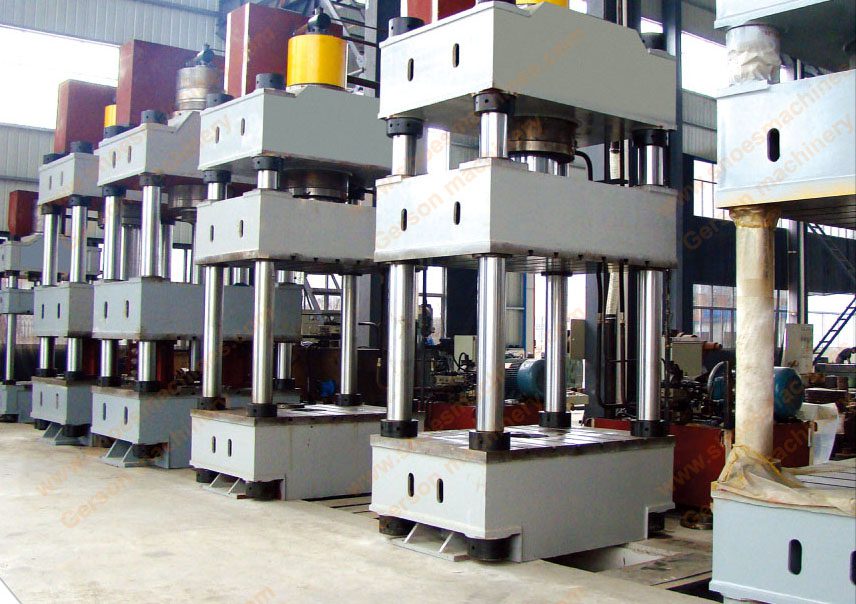
For over 38 years, Gerson has been at the forefront of beam press manufacturing, delivering high-quality, reliable, and efficient solutions to industries worldwide. Our Gerson brand beam presses have earned a stellar reputation for precision, durability, and performance.
Tailored to Your Needs:
Gerson offers a diverse range of beam presses, including swing beam presses, full beam presses, traveling beam presses, movable beam presses, and straight ram beam presses. These machines are available in various models and sizes, from compact manual presses to large-scale, fully automatic production systems.
Swing Beam Press
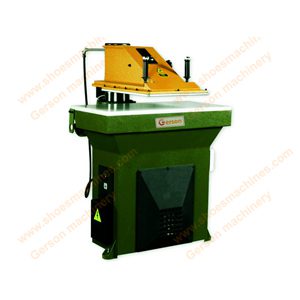
Gerson Swing Beam Press is also known as swing beam hydraulic press .It is easy entry level hydraulic press for small production.It is using for die cutting or punching or forming non-metal material such as leather,plastic,rubber,plastic,fabric etc.,
Fixed Beam Press
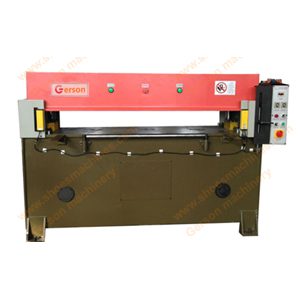
Fixed Beam Press is full beam hydraulic press with upper fixed beam .Like a nomal hydraulic press ,Gerson full beam or head press ensure cutting out large pieces both metal or non-metal material in roll or sheet etc., in large volume production capacity.
Movable Beam Press
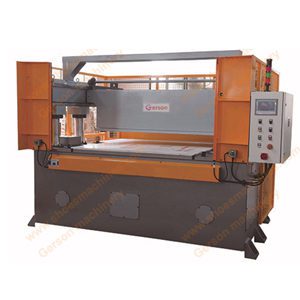
Gerson Movable Beam Press is one of beam press with moving or traveling beam or head .With its large working table and movable beam ,so It can be used in automatic cutting or punching or forming for both sheet and roll material.
Straight Ram Beam Press
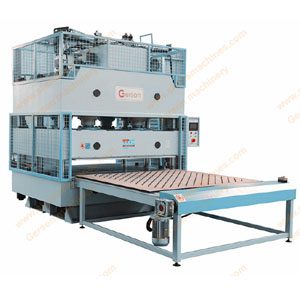
Straight Ram Beam Press is large size of beam press .It have Straight Ram mechanical press and Straight Ram hydraulic press.It can be large pressure because of Ram and three beams.equip with 4 posts or pillars or 6 posts or even 8 posts etc.,
Have Question? Ask Now
Beam Press:The Ultimate FAQ Guide(keep updating: Updated on Nov. 14th, 2024.)
This guide provides a comprehensive overview of beam press technology, from its basic principles to advanced applications. It covers various types, components, maintenance, and troubleshooting tips. Gerson, a trusted manufacturer, offers high-quality beam press solutions to meet diverse needs. By understanding these concepts, you can optimize your production processes and achieve optimal results by the FAQs.
Beam Press:The Ultimate FAQ Guide
1.What is a Beam Press?
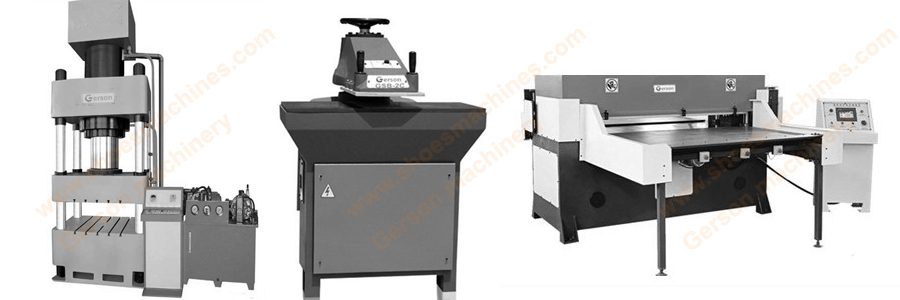
A beam press is a type of industrial machine that utilizes a long, sturdy metal beam to exert pressure on materials. This pressure is used to perform various metalworking operations, including cutting, forming, punching, and stamping.
The machine’s primary component, the beam, can be positioned either at the top or bottom of the press. During operation, the beam is mechanically driven downward or upward, applying significant force to the workpiece.
Beam presses can be further categorized based on their specific function:
- Beam Cutting Press: Designed for cutting materials to precise dimensions.
- Beam Forming Press: Used to shape and bend materials into desired configurations.
- Beam Punching Press: Employed to create holes or openings in materials.
- Beam Stamping Press: Utilized to imprint designs or patterns onto materials.
2.Which Materials can You Produce Using a Beam Press?
Beam press machines are highly versatile tools capable of processing a wide range of materials. Some common materials that can be easily pressed using a beam press include:
- Soft Materials: Leather, fabric, paper, cardboard, foam, sponge, rubber, cork
- Semi-Hard Materials: Plastic, composite
- Hard Materials: Wood, metal (steel, aluminum, copper)
Beam presses can handle materials in various forms, such as sheets, rolls, or webs. The machine’s ability to accommodate a wide range of material properties, from soft to hard, makes it an invaluable asset in many industries.
3.What are the Uses of a Beam Press?
You can use the beam press machine in a number of applications.
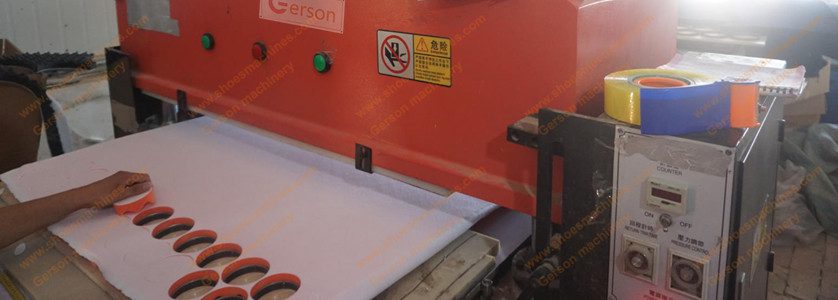
Beam presses are workhorses in many industries due to their ability to handle diverse applications. Here’s a breakdown of their key uses:
1. Die Cutting:
Beam presses excel at die cutting. A specialized die applies pressure to the material, creating precise shapes for various products. This technique is crucial for industries like:
- Footwear: Die-cutting leather shoe uppers is a prime example.
- Packaging: Creating boxes, inserts, and other packaging components.
Beyond simple cut-outs, beam presses can perform sophisticated die-cutting techniques:
- Kiss-cutting: Partially cuts through the material, allowing for easy removal without complete separation.
- Creasing: Creates fold lines in materials like cardboard for easier bending.
- Perforation: Punches tiny holes in a pattern for easy tearing.
- Embossing: Raises or depresses designs on a material for a textured effect.
- Stripping: Removes excess material around a die-cut shape.
2. Punching:
Beam presses can function as powerful punch presses. This involves using a punch tool to create holes, cut shapes, or even form the material. Compared to conventional punch presses with limited working areas, beam presses offer:
- Larger working areas: Process bigger materials and create multiple punches simultaneously, leading to faster production.
3. Beyond Die Cutting and Punching:
Beam presses extend their usefulness to other metalworking and fabrication processes, including:
- Forging: Shaping metal by applying compressive force.
- Clinching: Fastening two sheet metal pieces together using a controlled folding process.
- Molding: Pressing material into a specific shape using a mold.
- Blanking: Shearing and separating a desired shape from a sheet of material.
- Drawing: Deep-drawing shapes from sheet metal.
- Forming: Bending and shaping materials into specific configurations.
The versatility of beam presses makes them valuable assets across various industries, from manufacturing and construction to packaging and automotive.
4.How a Beam Press Works?
Beam presses come in two main power configurations: mechanical and hydraulic. Each offers distinct advantages for different applications.
1. Mechanical Beam Presses:
These workhorses rely on various mechanisms to convert rotary motion from a motor into linear pressure on the material. Here are some common types:
- Crank Linkage or Elbow Rod: This classic mechanism uses a rotating crankshaft to drive a connecting rod that pushes the beam up and down.
- Cam Mechanism: A cam with a specific profile rotates and contacts a follower arm, pushing the beam in a controlled motion.
- Screw Mechanism: A rotating screw shaft translates into linear movement of the beam, suitable for precise pressure applications.
2. Hydraulic Beam Presses:
These utilize the principles of hydraulics for powerful and controlled pressure. Here’s a breakdown of their operation:
- Components: The core components include cylinders, pistons, hydraulic pipes, and an oil pump.
- Operation: The oil pump pressurizes oil, which flows to a valve block. The valves then direct the pressurized oil to either the upper or lower chamber of the hydraulic cylinder.
- Pascal’s Law: These presses operate based on Pascal’s Law, which states that pressure applied to a confined liquid transmits equally throughout the system. This allows for precise force control.
Choosing the Right Beam Press:
The choice between mechanical and hydraulic presses depends on your needs. Here’s a quick guide:
- Mechanical: Ideal for simpler tasks requiring high-speed operation and cost-effectiveness.
- Hydraulic: Best suited for applications demanding precise force control, deeper strokes, and higher tonnage capacities.
The below video is beam press for foam die cutting:
5.What are The Types of Beam Presses?
When selecting a beam press for your production needs, consider the following factors:
Based on Beam Type
- Swing Beam Press: Offers flexibility for various operations, allowing the beam to pivot left or right.
- Fixed Beam Press : Provides stability and is ideal for consistent, repetitive tasks.
- Movable Beam Press : Offers versatility, with the beam moving either horizontally or vertically.
- Straight Ram Press: Designed for larger-scale operations, providing a direct, powerful force.
| Beam Type | Description | Applications |
|---|---|---|
| Swing Beam Press | Offers flexibility for various operations, allowing the beam to pivot left or right. | Versatile for different part shapes and sizes. |
| Fixed Beam Press | Provides stability and is ideal for consistent, repetitive tasks. | Suitable for high-volume production of identical parts. |
| Movable Beam Press | Offers versatility, with the beam moving either horizontally or vertically. | Adaptable to different part geometries and sizes. |
| Straight Ram Press | Designed for larger-scale operations, providing a direct, powerful force. | Ideal for heavy-duty forming, cutting, and punching operations. |
Based on Number of Beams
- Double Beam Press: Standard configuration with one upper and one lower beam.
- Three Beam Press: Offers increased force and precision, especially for complex forming operations.
| Number of Beams | Description | Applications |
|---|---|---|
| Double Beam Press | Standard configuration with one upper and one lower beam. | General-purpose forming, cutting, and punching operations. |
| Three Beam Press | Offers increased force and precision, especially for complex forming operations. | Deep drawing, bending, and forming of intricate shapes. |
Based On Number of Columns (Also Called Post Or Pillars )
The number of columns in a beam press significantly impacts its stability, rigidity, and load-bearing capacity. Here’s a breakdown of common configurations:
1.Double Column Beam Press
- Stability: Offers good stability, especially for smaller and medium-sized presses.
- Applications: Suitable for a wide range of applications, including forming, cutting, and punching.
- Limitations: May experience some deflection under heavy loads, especially for larger presses.
2.Four Column Beam Press
- Stability: Provides excellent stability and rigidity, making it suitable for heavy-duty applications.
- Applications: Ideal for large-scale forming, cutting, and punching operations, as well as deep drawing.
- Advantages: Reduces deflection, improves accuracy, and extends the life of tooling.
3.Six Column Beam Press
- Stability: Offers exceptional stability and rigidity, making it suitable for extremely heavy-duty applications.
- Applications: Ideal for large-scale forming, cutting, and punching operations, as well as deep drawing.
- Advantages: Minimizes deflection, ensuring precise and consistent results.
4.Eight Column Beam Press
- Stability: Provides maximum stability and rigidity, making it suitable for the most demanding applications.
- Applications: Ideal for extremely large-scale forming, cutting, and punching operations, as well as deep drawing.
- Advantages: Offers exceptional accuracy and precision, even under the heaviest loads.
| Number of Columns | Stability | Applications | Advantages |
|---|---|---|---|
| Double Column Beam Press | Good | Forming, cutting, punching | Simple design, cost-effective |
| Four Column Beam Press | Excellent | Large-scale forming, cutting, punching, deep drawing | Reduced deflection, improved accuracy |
| Six Column Beam Press | Exceptional | Extremely heavy-duty applications | Minimized deflection, precise results |
| Eight Column Beam Press | Maximum | Extremely large-scale applications | Exceptional accuracy and precision |
Base On Power Transmission
- Hand-Operated Beam Press: Suitable for small-scale, low-force applications.
- Mechanical Beam Press: Employs mechanical linkages to convert rotary motion into linear force.
- Hydraulic Beam Press: Leverages hydraulic pressure for powerful and precise force control.
- Pneumatic Beam Press: Uses compressed air to drive the press, offering flexibility and speed.
| Power Transmission | Description | Applications |
|---|---|---|
| Hand-Operated Beam Press | Suitable for small-scale, low-force applications. | Manual operation for simple tasks. |
| Mechanical Beam Press | Employs mechanical linkages to convert rotary motion into linear force. | Versatile for various applications, offering moderate force and speed. |
| Hydraulic Beam Press | Leverages hydraulic pressure for powerful and precise force control. | Ideal for heavy-duty applications requiring high force and precise control. |
| Pneumatic Beam Press | Uses compressed air to drive the press, offering flexibility and speed. | Suitable for rapid, repetitive tasks. |
Based on Tonnage
- Mini Beam Press: Low-tonnage presses suitable for small-scale operations and delicate materials .Usually it is is hand beam press less than 5 ton beam press. for example: 1 ton beam press,2 ton beam press,3 tons ,4 tons 5 tons etc.,
- Small Beam Press: Medium-tonnage presses for a wide range of applications.Usually it is less than 50 tons .for example 10 ton beam press,20 ton beam press,25 ton beam press ,30 ton beam pres,40 ton beam press, 50 ton beam press.
- Medium Beam Press: High-tonnage presses for heavy-duty forming and cutting operations.Usually it is fixed or movable beam press from 50 ton to 500 tons. For example : 100 ton beam press,200 ton beam press,500 ton beam press etc.,
- Large Beam Press: Extremely high-tonnage presses for specialized applications.Usually it is full beam press more than 500 tons pressure. For example : 1000 ton beam press,2000 ton beam press,5000 ton beam press etc.,
Tonnage Range | Description | Applications |
|---|---|---|
| Mini Beam Press(1-5 tons) | Low-tonnage presses suitable for small-scale operations and delicate materials. | Jewelry making, electronics assembly, and small part production. |
| Small Beam Press(10-50 tons) | Medium-tonnage presses for a wide range of applications. | Sheet metal forming, cutting, and punching. |
| Medium Beam Press(100-500 tons) | High-tonnage presses for heavy-duty forming and cutting operations. | Automotive components, structural parts, and large-scale metalworking. |
| Large Beam Press(1000 tons+) | Extremely high-tonnage presses for specialized applications. | Forging, heavy-duty stamping, and large-scale metal forming. |
Based On Power Source
Pneumatic Power
- Power Source: Compressed air
- Energy Transfer: Less efficient due to energy losses in the compression and transmission of air.
- Advantages:
- Clean and dry operation
- Simple and reliable design
- Fast response times
- Low initial cost
- Disadvantages:
- Lower energy efficiency
- Limited force and pressure capabilities
- Potential for air leaks and noise
Hydraulic Power
- Power Source: Hydraulic fluid (typically oil)
- Energy Transfer: More efficient due to the direct transmission of fluid pressure.
- Advantages:
- High force and pressure capabilities
- Smooth and precise control
- High energy efficiency
- Wide range of applications
- Disadvantages:
- Potential for fluid leaks
- Requires careful maintenance
- Higher initial cost
| Feature | Pneumatic Power | Hydraulic Power |
|---|---|---|
| Power Source | Compressed air | Hydraulic fluid (oil) |
| Energy Efficiency | Lower | Higher |
| Force and Pressure Capabilities | Limited | High |
| Precision and Control | Moderate | High |
| Speed of Operation | Fast | Moderate |
| Maintenance Requirements | Lower | Higher |
| Environmental Impact | Cleaner and quieter | Potential for fluid leaks and noise |
| Initial Cost | Lower | Higher |
6.What are The Application of Beam Press?
You can use a beam press machine to make different products for different purposes.Beam press machines are versatile tools used in a wide range of industries. Here’s a breakdown of some common applications:
| Industry | Applications |
|---|---|
| Abrasive | Discs, pads, belts, strips, scouring pads, abrasive textiles, foams |
| Advertising | Signs, displays, banners,Parts etc., |
| Aerospace & Automotive | Airbags, anti-rattle components, bodywork delivery, protection, badges, decals, boot liners, catalytic converter components, carpets, mats, door casings, filters, gaskets, headrests, interior trim, insulation panels, leather seating, number plates, parcel shelf panels, roof liners, seating components, steering wheel covers, sun visors, sound absorption panels, wheel protectors, sealing components, vibration control, brake pads, insert molding, floor mats, carpets, truck bed liners, electrical connectors, insulators, fuel delivery parts, windshield wiper blades, gear assemblies, airplane body panels, wings |
| Clothing | Belts, brassieres, briefs, caps, collars, cuffs, gloves, hats, leather clothing, lingerie, outerwear, protective suits, shoulder pads, tie linings, underwear, body armor, head gear liners, industrial gloves, knee pads, protective suits |
| Cosmetics | Cosmeceutical pads, cosmetic puffs, masks |
| Electrical | Electrical conductors, insulators, filters, seals, flexible PCBs, hard disk components, heat dissipative materials, key pad overlays, LCD screens, membrane switches, mobile phone components, wafer processing aids |
| Electronics | Optical films, plastic films, LCDs, bonding and sealing gaskets, thermal management pads, speaker and microphone filters, electronic device housing vents, touch screen optically clear adhesive and film, circuit board attachment, electrical conduction, spacers, cushioning, light blocking, reflection, gaskets, spacers, shims, EMI/RFI shielding, membrane switch components, shock, vibration, and noise dampeners, printed electronics, LED lighting, flex circuit components |
| Foam | Packaging inserts, case inserts, cosmetic pads, foam/abrasive scouring pads, shaped cleaning sponges, insulation, acoustic products, medical foam, filters, automotive components, seals, gaskets, self-adhesive products, general packaging, furniture |
| Medical | Skin contact tapes, foams, pharmaceutical filtration components, thermal management materials, conductive adhesives, EMI/RFI shielding, electrode pads, probe shields/covers, protective face shields, surgical patches, bonding and surface mount adhesives, gaskets, spacers, shims, electrical insulators, instrumentation gaskets and seals, diagnostic test strip components, medical device components, medical electronics components, cosmeceutical pads |
| Packaging | Blister packs, cake boards, cardboard, corex, corrugated, de-flashing, foam case inserts, food packaging, medical industry packaging, take-away carton lids, vacuum formed packing, paperboard, corrugated boards, board boxes, plastic boxes, vacuum packages, gaskets, filters |
| Shoes | Sock lining, EVA sock lining, tongue, midsole/insole, upper, quarter, vamp, heel counter |
| Sports | Footballs, baseballs, volleyballs, tennis balls |
7.What are the Benefits of a Beam Press ?
Beam press machines offer numerous advantages for various production applications. Here’s a breakdown of the key benefits:
| Benefit | Description |
|---|---|
| Increased Speed | Beam presses create cutouts quickly and efficiently with dies. A single press can produce numerous pieces in a short time. Fully automatic models can generate thousands of cutouts within minutes. |
| Reduced Labor Costs | Automation eliminates the need for multiple workers for cutting and forming tasks. Beam presses can be operated by a single person, significantly reducing labor costs. |
| Boosted Production | Due to their automation capabilities, beam presses are highly efficient for high-volume production. They minimize waste compared to other methods and allow for increased output. |
| Simplified Operation | Modern beam presses are designed for user-friendly operation, requiring minimal training. Intuitive controls make them easy to learn and operate. |
| Reduced Maintenance Needs | Hydraulic beam presses use oil as the working medium, which lubricates moving parts for extended service life. Their design simplifies daily maintenance and minimizes downtime. |
By leveraging these benefits, beam press machines can significantly enhance production efficiency and cost-effectiveness for various industries.
8.What are the Disadvantages of a Beam Press?
Beam press machines, while versatile and efficient, present several limitations that can impact their suitability for certain manufacturing processes:
| Disadvantage | Description |
|---|---|
| High Initial Cost | The purchase price can be significant, especially for high-capacity models or those with advanced features. |
| Maintenance Demands | Regular maintenance is required to ensure optimal performance and longevity. This includes checking hydraulic systems, lubricating moving parts, and inspecting for wear and tear. Neglecting maintenance can lead to breakdowns, which can be costly in terms of repairs and downtime. |
| Operator Skill Requirement | Operating a beam press effectively often requires skilled personnel who understand the machine’s mechanics and operational parameters. Training new operators can take time and resources, and inexperienced operators may lead to inefficiencies or errors in production. |
| Limited Complexity | While beam presses are excellent for straightforward cutting and forming tasks, they may struggle with more complex shapes or intricate designs compared to other machining methods like laser cutting or CNC machining. This limitation can restrict their use in industries requiring high precision or detailed work. |
| Size Constraints | The physical size of beam presses can limit the dimensions of materials that can be processed. Large sheets or rolls may not fit within the machine’s working area, necessitating additional handling equipment or processes. |
| Noise Pollution | Beam presses can generate significant noise during operation due to the mechanical movements involved in pressing materials. This noise pollution may require additional soundproofing measures in a manufacturing environment to comply with occupational safety regulations. |
| Energy Consumption | Depending on the type (mechanical vs hydraulic), beam presses can consume considerable amounts of e |
In conclusion, while beam presses offer numerous advantages, manufacturers should carefully consider these disadvantages when integrating them into their production lines.
9.What are the Main Parts of Beam Press Machine?
A beam press is a versatile machine used in various industries for cutting, forming, and stamping materials. It consists of three primary components:
1. Mechanical Components
- Press Body: The main frame of the machine, providing structural support.
- Work Mechanism: Includes the ram, slide, and connecting linkages, which transmit force to the cutting or forming tool.
- Stroke Adjustment Device: Allows for precise control of the ram’s travel distance.
- Feeding Devices:
- Slide Saddle Mobile Feeding Device: A manual or motorized mechanism to position the material under the ram.
- Automatic Feeding Device: A more advanced system for automated material feeding.
2. Hydraulic System
- Hydraulic Pump: Generates high-pressure hydraulic fluid.
- Hydraulic Cylinder: Converts hydraulic pressure into mechanical force to drive the ram.
- Control Valves: Regulate the flow and pressure of hydraulic fluid.
- Auxiliary Components: Filters, oil tank, pressure gauges, etc., ensure efficient and safe operation.
3. Electrical Control System
- Switches, Relays, and Contactors: Control the operation of the machine.
- Safety Devices: Photoelectric sensors, emergency stop buttons, and other safety features protect the operator.
- Control Panel: Provides a user-friendly interface for monitoring and controlling the machine.
| Component | Description |
|---|---|
| Mechanical Components | |
| Press Body | The main frame, providing structural support. |
| Work Mechanism | Includes the ram, slide, and connecting linkages, transmitting force to the tool. |
| Stroke Adjustment Device | Controls the ram’s travel distance. |
| Feeding Devices | |
| Slide Saddle Mobile Feeding Device | Manual or motorized mechanism for material positioning. |
| Automatic Feeding Device | Automated system for material feeding. |
| Hydraulic System | |
| Hydraulic Pump | Generates high-pressure hydraulic fluid. |
| Hydraulic Cylinder | Converts hydraulic pressure into mechanical force. |
| Control Valves | Regulate fluid flow and pressure. |
| Auxiliary Components | Filters, oil tank, pressure gauges, etc. |
| Electrical Control System | |
| Switches, Relays, and Contactors | Control machine operation. |
| Safety Devices | Photoelectric sensors, emergency stop buttons, etc. |
| Control Panel | User-friendly interface for monitoring and control. |
By understanding these components, you can better appreciate the functionality and capabilities of a beam press.
10.Which Parts of a Beam Press Machine Wears Out Faster ?
Knowing which parts of a beam press wear out faster allows for proactive maintenance and reduces downtime. Here’s a breakdown of the most susceptible components:
1. Consumables:
- Half a year of use (even if not constantly running)
- Non-operation for extended periods
- 1000-2000 hours of operationHydraulic Oil: This oil needs regular replacement to maintain optimal performance and prevent wear on hydraulic components. The frequency depends on the specific equipment, oil type, and usage. A general guideline suggests changing it after:
2. Wear Parts:
- Die Tools: These experience the most wear due to constant up-and-down movement and pressure during cutting and forming. Both the punching die and the cutting die are susceptible to dulling and require sharpening or replacement over time.
3. Protective Elements:
- Cutting Pad/Board: This sits on the worktable and protects the die tools from direct contact with the material being processed. It absorbs impact and extends the life of the dies. Made from wear-resistant polymer composites, it can often be used on both sides due to its high toughness and low specific gravity. However, it will eventually wear out and need replacing.
By proactively monitoring and replacing these components, you can ensure smooth operation, minimize downtime, and extend the overall lifespan of your beam press
11.What is the State-of-the-Art Technology for Beam Press ?
Beam presses, a cornerstone of many manufacturing processes, have seen significant advancements in recent years. Among the leading innovators in this field is Gerson, renowned for its cutting-edge technology and commitment to customer satisfaction.
Gerson’s 4th Generation Hydraulic Beam Press
Gerson’s latest innovation, the 4th generation hydraulic beam press, represents the pinnacle of beam press technology. Key features and benefits include:
- Patented Hydraulic System: Delivers exceptional performance, precision, and efficiency.
- High Stability: Ensures consistent and reliable operation.
- Low Noise: Reduces noise pollution and improves working conditions.
- High Efficiency: Optimizes production processes and minimizes downtime.
Advanced Automation
Gerson’s fully automated beam presses take productivity to new heights. Features like automatic feeding, pick-up, and packaging enable unattended operation, reducing labor costs and increasing output.
High-Quality Components
Gerson’s commitment to quality is evident in the use of premium hydraulic systems, electrical components, and other parts. This ensures long-lasting performance and minimal maintenance requirements.
By embracing innovation and focusing on customer needs, Gerson continues to shape the future of beam press technology. Their state-of-the-art machines are driving efficiency, productivity, and sustainability in manufacturing industries worldwide.
12.How Many Shapes Can Produce Using a Beam Press Machine
At Gerson, we understand your concern about producing products with various shapes using our beam presses. The good news is, Gerson beam presses offer a high degree of adaptability thanks to the power of custom die tooling.
Here’s how it works:
- Die Tool Mold System: The final shape of your product is determined by the die cutter mold used in the press. Different dies create different shapes.
- Customization is Key: If you require a variety of product shapes, you’ll need corresponding custom dies. These dies precisely define the cutting or forming pattern for your specific needs.
- Gerson’s Die Facility: We have our own dedicated facility for manufacturing die tooling systems. This allows us to create custom dies that address your unique product shapes, even those that are complex.
Benefits of Custom Dies with Gerson:
- Versatility: Produce a wide range of product shapes with just one Gerson beam press by simply switching the dies.
- Precision: Our custom dies are meticulously crafted for accurate and consistent results.
- Efficiency: Eliminate the need for multiple machines by using a single press with interchangeable dies.
- Convenience: Gerson provides a one-stop solution for both your beam press and custom die needs.
Gerson Beam Presses: Your Partner in Shape Creation
Don’t let product shape complexity be a barrier. With Gerson’s adaptable beam presses and in-house die manufacturing capabilities, we can help you achieve the precise shapes you require for your products. Contact us today to discuss your specific needs and explore how Gerson can be your partner in shape creation.
13.What Kind of Die Tools Can Be Used on a Beam Press?
In order to be able to make customized products, the press must be equipped with customized die, so that we can produce the products we want. There are the following types of die cutter mold tools for the beam press:
1.For Cutting Soft and Semi-rigid Material
Steel Rule Die:It is a very popular knife die mold.Steel rule a pre-hard or pre-sharp steel rule die blade which a sheet of metal that has a hardened cutting edge.the steel rule die consists of three major parts: a die base (board), steel rule cutting blade, and rubber ejection material.
Presharp Die: It is also very common die knife mold .It equiped wth a optimum hardness steel which is pre-hardened and pre-sharpened cutting edge .
2.For Rigid Material,Such as Metal Die:
Single Punch Die:This is the simplest type of die mold. It can be forming or cutting or bending or deep drawing in one step. Only one punching process is completed in one movement of the beam press machine.
Compound Die : In one stroke, both the inner hole and the outer shape of the upper process punching die are completed on the same station of the die at the same time.
Continuous Die: also called progressive die by some masters, is a difficult type of die among the molds. It uses an automatic material feeder and has two or more processes at the same time. In the process, two or more stamping processes are completed successively.
14.What is a Swing Beam Press?
A swing beam press, also known as a swing beam clicker press, swing arm cutting machine, or swing arm clicker press, is a specialized type of beam press designed for smaller-scale cutting and forming operations.
Key Feature: The Swinging Beam
The defining characteristic of a swing beam press is its ability to swing the upper beam left or right. This feature allows for precise positioning of the cutting material and die, making it ideal for intricate cutting patterns and smaller components.
Typical Applications:
- Leather and Textile Industries: Cutting leather, fabric, and other soft materials.
- Shoe Manufacturing: Cutting various shoe components.
- Automotive Industry: Cutting smaller automotive parts.
- Electronics Industry: Cutting circuit boards and other electronic components.
Advantages of Swing Beam Presses:
- Precision: The swinging beam mechanism enables accurate positioning of the cutting tool.
- Versatility: Suitable for a wide range of materials and applications.
- Compact Design: Requires less floor space compared to larger beam presses.
- Ease of Operation: User-friendly controls and intuitive design.
While swing beam presses are well-suited for smaller-scale operations, they may not be as powerful or efficient as larger beam presses. However, for many applications, they offer a cost-effective and precise solution.For more information ,You could see more details on the below link :Swing Arm Clicker Press.
15.What is a Full Beam Press?
The full beam press, also known as a full head press, offers a unique design in the beam press family. Unlike standard presses with a smaller upper beam, a full beam press boasts an upper plate that matches the entire size of the work surface. This maximizes the usable area and allows for larger-scale projects.
Types of Full Beam Presses:
There are two main configurations within the full beam press category:
- Fixed Beam Press: This type features a stationary upper plate that can only move vertically (up and down) for pressing operations.
- Movable Beam Press (Receding Beam Press): In this version, the upper plate can move both vertically and horizontally (back and forth). This additional movement allows for easier loading and unloading of materials, especially when dealing with large or bulky pieces.
Advantages of Full Beam Presses:
- Maximum Work Area: The full-size upper plate maximizes the usable area, enabling processing of larger materials or multiple pieces simultaneously.
- Uniform Pressure Distribution: The full coverage of the upper plate ensures a more even distribution of pressure across the material, leading to consistent results.
- Greater Flexibility: The movable beam press offers improved accessibility for loading and unloading large materials.
Applications of Full Beam Presses:
- Metalworking: Cutting, forming, and stamping large metal sheets.
- Composite Materials: Processing large composite panels for various applications.
- Gaskets and Seals: Die-cutting gaskets and seals in large quantities.
- Automotive Industry: Creating large automotive components and parts.
While offering significant benefits, full beam presses are typically heavier and more expensive than their standard counterparts. Their larger size may also require a more spacious working environment.
Choosing the Right Beam Press:
The choice between a swing beam press, full beam press, or a standard beam press depends on your specific needs. Consider factors like the size and complexity of your materials, desired processing capabilities, production volume, and available workspace.
16.What is the Difference between Swing Beam Press and Full Beam Press?
1. Beam Structure and Die-Cutting Capabilities:
- Swing Beam Press:
- The upper beam can swing left and right, allowing for precise positioning of the die.
- Due to the smaller upper platen size, die-cutting is limited to areas within this size.
- Full Beam Press:
- The upper platen covers the entire work surface, enabling die-cutting across the entire area.
- This makes it suitable for larger-scale die-cutting projects.
2. Work Surface Size:
- Swing Beam Press:
- Typically limited to smaller work surfaces, often around 1200mm x 500mm.
- Full Beam Press:
- Offers a wide range of work surface sizes, from smaller to very large (e.g., 3000mm x 2000mm).
3. Working Pressure:
- Swing Beam Press:
- Lower working pressure, typically around 30 tons or less.
- Full Beam Press:
- Can handle significantly higher working pressures, ranging from hundreds to thousands of tons.
4. Material Cutting Capabilities:
- Swing Beam Press:
- Primarily suited for cutting soft and semi-hard materials like leather, fabric, and certain types of plastics.
- Full Beam Press:
- Capable of cutting a wider range of materials, including hard materials like metal sheets.
| Feature | Swing Beam Press | Full Beam Press |
|---|---|---|
| Beam Structure | Swinging upper beam | Fixed upper beam |
| Die-Cutting Area | Limited to the size of the upper platen | Can cover the entire work surface |
| Work Surface Size | Smaller, typically 1200mm x 500mm or less | Can be much larger, up to 3000mm x 2000mm or more |
| Working Pressure | Lower, usually around 30 tons or less | Higher, ranging from hundreds to thousands of tons |
| Material Cutting Capability | Soft and semi-hard materials | Soft, semi-hard, and hard materials (including metals) |
In Conclusion:
The choice between a swing beam press and a full beam press depends on several factors, including:
- Material Thickness and Hardness: For thicker and harder materials, a full beam press with higher pressure is necessary.
- Die-Cutting Area: If you need to die-cut large sheets of material, a full beam press is more suitable.
- Production Volume: For high-volume production, a full beam press with automation capabilities can be more efficient.
- Budget: Full beam presses, especially large-scale ones, can be more expensive than swing beam presses.
By carefully considering these factors, you can select the right beam press for your specific application.
17.How Many Tons of Force are Needed for a Beam Press to Cut Parts?
The tonnage required for a beam press to cut specific parts depends on several factors:
- Material Thickness and Hardness: Thicker and harder materials require higher tonnage.
- Die Design and Complexity: The complexity of the die and the number of cutting edges can influence the required tonnage.
- Desired Cutting Speed: Higher cutting speeds may necessitate higher tonnage.
- Desired Accuracy and Precision: More precise cuts may require higher tonnage to ensure clean and accurate results.
General Guidelines:
- Soft Materials (e.g., leather, fabric): Lower tonnage, typically in the range of 25-100 tons.
- Medium-Hardness Materials (e.g., rubber, plastic): Medium tonnage, typically in the range of 100-300 tons.
- Hard Materials (e.g., metal sheets): Higher tonnage, often exceeding 300 tons.
Consulting with Experts:
The exact tonnage required for a beam press will depend on specific details about your application, including material type, thickness, die design, and cutting dimensions. For most applications involving beam presses, you would typically need between 30 tons to 500 tons, depending on various factors such as those outlined above.
However, it’s important to consult with experts or manufacturers like Gerson to determine the exact tonnage needed for your specific application. They can provide tailored advice and help you select the most suitable beam press
Remember:
Underestimating the required tonnage can lead to suboptimal cutting performance, while overestimating can result in unnecessary costs. It’s essential to strike the right balance to achieve efficient and effective cutting operations.
18.How to choose a beam press for production?
When selecting a beam press, it’s crucial to consider your specific needs and budget. Here’s a step-by-step approach to help you make an informed decision:
1. Define Your Requirements:
- Product Type and Shape: Determine the specific products you’ll be manufacturing.
- Material Type and Thickness: Identify the materials you’ll be working with (e.g., metal, plastic, rubber).
- Production Volume: Estimate your daily or monthly production targets.
- Level of Automation: Decide whether you need a manual, semi-automatic, or fully automatic press.
2. Assess Your Budget:
- Initial Investment: Consider the upfront cost of the press, including the machine itself, tooling, and installation.
- Operating Costs: Factor in energy consumption, maintenance, and labor costs.
3. Consider Key Features:
- Press Capacity: Ensure the press can handle the weight and thickness of your materials.
- Stroke Length: Verify that the stroke length is sufficient for your cutting or forming operations.
- Ram Speed: Select a speed that balances productivity and precision.
- Accuracy and Repeatability: Look for machines with high levels of accuracy and consistency.
- Safety Features: Prioritize safety features like emergency stops and safety guards.
4. Evaluate the Supplier:
- Reputation and Experience: Choose a reputable manufacturer with a proven track record.
- After-Sales Support: Consider the availability of technical support and spare parts.
- Customization Options: Assess the supplier’s ability to tailor the press to your specific needs.
Gerson’s beam presses are equipped with advanced features to enhance productivity and precision. Tailored solutions to match your specific requirements.Gerson presses offer long-lasting durability and dedicated support team to assist with installation, maintenance, and troubleshooting. Gerson offers a wide range of beam press solutions to meet diverse manufacturing needs.
5. Seek Expert Advice:
- Consult with Industry Professionals: Seek advice from experienced engineers or technicians.
- Discuss with Suppliers: Engage with multiple suppliers to compare offerings and pricing.
Key Factors to Consider:
- Swing Beam Press: Ideal for smaller-scale operations, offers flexibility and precision.
- Full Beam Press: Suitable for larger-scale production, provides greater power and versatility.
By carefully considering these factors, you can select the most suitable beam press for your manufacturing needs. Remember, the best press is one that meets your specific requirements and provides long-term value.
19.Why Does Choose Beam Press?
Gerson Beam Press is a trusted name in the industry, offering a range of high-quality beam press solutions. Here’s why you should consider choosing Gerson:
1. Decades of Experience and Expertise:
- Over 38 years of manufacturing excellence.
- Deep understanding of industry needs and challenges.
- Proven track record of delivering reliable and efficient solutions.
2. Diverse Product Range:
- Over 1000 different custom beam presses have manufactuered to suit various applications, including:
- Swing beam presses for precise cutting and forming
- Full beam presses for large-scale production
- Movable beam presses for flexible operations
- Capable of handling a wide range of materials, from delicate fabrics to tough metals.
3. Advanced Technology and Innovation:
- Cutting-edge hydraulic systems for efficient and precise operations.
- Innovative design features to reduce noise pollution by up to 30% and energy consumption by 20%.
- Customization options to meet specific production requirements.
4. High Production Capacity and Efficiency:
- Robust construction and powerful cutting forces for high-volume production.
- Optimized machine design for minimal downtime and maximum productivity.
- Advanced automation features to streamline operations.
5. Comprehensive Support and Services:
- Expert installation and commissioning services.
- Comprehensive training programs for operators and maintenance personnel.
- Prompt and reliable after-sales support.
- Regular maintenance and service contracts to ensure optimal performance.
6. Safety and Environmental Considerations:
- Adherence to stringent safety standards to protect operators.
- Energy-efficient designs to reduce environmental impact.
- Noise reduction measures to improve workplace conditions.
By choosing Gerson, you’re investing in a reliable, efficient, and sustainable beam press solution that will elevate your manufacturing operation
20.What is the Price of Beam Press?
The price of a beam press can vary significantly based on several factors:
- Maximum Working Pressure: Higher pressure capabilities generally lead to higher costs.
- Work Area: Larger work areas require larger machines and therefore higher costs.
- Feeding Mechanism:
- Manual Feeding: Less expensive but requires manual labor.
- Automatic Feeding: More expensive but offers increased efficiency and productivity.
- Sheet Feeding: Suitable for sheet materials.
- Roll/Coil Feeding: Suitable for roll materials.
- Shipping Method and Destination: Shipping costs can vary based on distance and mode of transportation.
- Additional Features and Customization: Any specific requirements or customizations can impact the final price.
To Get an Accurate Quote:
For a precise quote, please provide the following information:
- Desired Working Pressure: The maximum pressure needed for your applications.
- Required Work Area: The dimensions of the materials you’ll be processing.
- Preferred Feeding Method: Manual, automatic sheet feeding, or automatic roll feeding.
- Shipping Address: Your location for delivery.
- Any Specific Requirements: Additional features or customizations you need.
By sharing these details, we can provide you with a tailored quote.
Remember:The best way to determine the exact cost of a beam press that meets your specific needs is to consult with a reputable manufacturer like Gerson. They can provide expert advice, accurate pricing, and high-quality equipment.
Conclusion
Beam presses are versatile machines widely used in various industries. Understanding their components, types, and applications is crucial for optimal usage. Gerson, a leading manufacturer, offers a range of high-quality beam presses tailored to diverse needs. By selecting the right beam press and leveraging Gerson’s expertise, businesses can enhance productivity, efficiency, and overall operational performance.